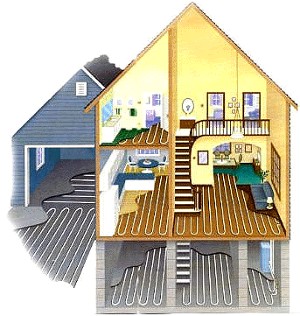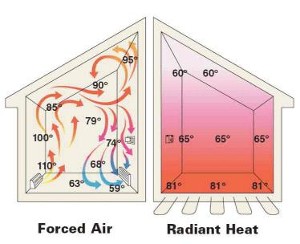HYBRID RADIANT HEATING:
Furnaces Used as Supplemental or Back-up Systems
Hybrid Radiant Heating: Furnaces Used as Supplemental or Back-up Systems
Radiant floor heating systems, hydronic or electric, are networks which circulate heat underneath the floor. If you have ever walked barefoot across a tile floor on a very cold night, then you can easily imagine the difference if you were walking across that same floor with radiant heat rising up through that floor.
These radiant floor systems, along with their hybrid radiant heating cousins, are becoming very popular, not only because of the comfort they provide, but also because of lower operating costs.
 These radiant floor systems can also provide multiple
zoning,
room-by-room, if installed accordingly. You may want to keep your Master bedroom quite warm but not the Guest room, which is seldom used. These areas can be tubed separately and controlled with their own thermostats. This flexibility can add to lower utility bills. The same scenario is possible with different levels of the home, which have different heating needs. North, South, East and West exposures have different requirements, as well. A well planned radiant system can be designed to address these issues.
These radiant floor systems can also provide multiple
zoning,
room-by-room, if installed accordingly. You may want to keep your Master bedroom quite warm but not the Guest room, which is seldom used. These areas can be tubed separately and controlled with their own thermostats. This flexibility can add to lower utility bills. The same scenario is possible with different levels of the home, which have different heating needs. North, South, East and West exposures have different requirements, as well. A well planned radiant system can be designed to address these issues.
According to the Radiant Panel Association, sales of hydronic heating systems in the US more than doubled between 2000 and 2006. People like their comfort.
Supplemental
Many of the homes we live in, or are building, have high ceilings and large windows, which means large heat losses and gains. Only so much radiant heat can be provided to these areas from the floor, therefore a supplemental heating need may exist. Your radiant designer should be able to identify these areas and make recommendations.
There are various means of supplying this supplemental heating. If the supplemental requirements are small, an auxilliary heater, such as an electric or hydronic toe space heater, may be installed.
For larger supplemental needs, more drastic measures must be planned. For example, additional radiant might be installed in the walls, or a hybrid radiant heating system might be considered. An
air handler
with a hydronic coil or
electric heat strips
can installed.
But, by far, the most common method for covering conventional radiant supplemental heating needs is installation of a forced air furnace.
Cover your supplemental needs with a forced air furnace
If you are planning a conventional air conditioner for your project, this is the perfect solution. Install a furnace in place of the air handler and your supplemental heating needs are covered. The cost difference between an air handler and an 80% AFUE furnace is minimal. Additional costs will be incurred by adding the gas line, venting the exhaust gases to the exterior and providing combustion air to the mechanical space.

Additional cost will be in the controls. You will want your furnace to be 2nd stage heating. The radiant floor heating will be the primary heat source, and the furnace will cycle on only when the radiant is not covering the demand. Controlling this system requires a tech familiar with this type of system.
First, both the radiant boiler and the furnace provide their own 24 volt power source.
One of these sources must be selected to power the thermostat, and the t-stat must be capable of calling upon either heating source to perform. This is accomplished through relays and installation of a 2-stage thermostat. The control wiring gets much more involved if your system will have zoning or humidification.
Back-up heating
Covering your supplemental needs is just one of many benefits afforded by installation of a secondary, or back-up heating system. A
gas-fired furnace
fits this bill exceptionally well.
Just as stated: Back-up heating. If your boiler fails for any reason, the furnace(s) will cycle on and keep your home heated until repairs have been made.
Also, once this happens and your floors have gone cold, it may be 8 hours until the radiant floors are back up to full capacity and satisfying the thermostat. With a hybrid radiant heating system with forced air heating back-up your inconvenience is minimal.
Many folks take extended vacations or leave on business trips for weeks or months at a time. Keeping your radiant at full capacity during that time is an unnecessary expense. And yet if you don't, you will be cold for hours waiting for your radiant to bring temps back up in your home, once you get back home. Not so with a forced air furnace back-up system. Walk in, turn up your thermostat(s), and within minutes your home is back up to a comfortable temperature. Your furnace(s) will handle the heating load until the radiant floors have caught up.
Indoor air quality distribution
Once you have determined that this type of back-up heating will be installed in your home, improved indoor air quality can be provided with this system, as well. Central air conditioning can be added. Humidification is very important in today's tightly constructed homes. This system can be the central component for your fresh air circulation in your home. Superior air filtration can be provided by this system. Free winter cooling or economizer air can be provided into high usage areas, such as home theaters, or exercise rooms.
Depart "Hybrid Radiant Heating" qnd Return to Radiant Heating main page
Depart "Hybrid Radiant Heating" and Return to HOME
Enjoy this page? Please pay it forward. Here's how...
Would you prefer to share this page with others by linking to it?
- Click on the HTML link code below.
- Copy and paste it, adding a note of your own, into your blog, a Web page, forums, a blog comment,
your Facebook account, or anywhere that someone would find this page valuable.